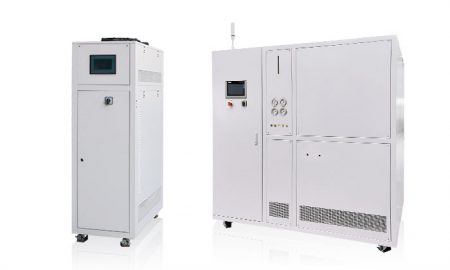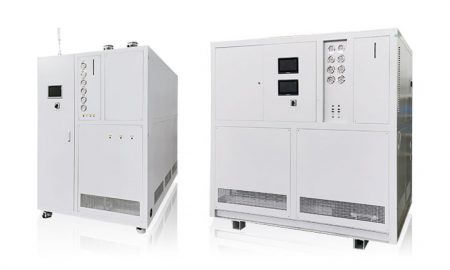Battery Pack Cooling System
There are three main cooling methods of battery pack cooling system:
1. Natural cooling: This method mainly uses the radiator (or cooling plate) of the battery system to absorb and dissipate the heat generated by the battery core, and achieves heat dissipation through heat convection and heat conduction. Natural cooling relies on the reasonable structural design of the battery system. The radiator can quickly and effectively transfer the heat generated by the battery core to other parts of the entire battery pack, and then other parts conduct the heat to the external environment. However, the effect of natural cooling is greatly affected by factors such as ambient temperature and wind speed, and the efficiency is relatively low.
2. Liquid cooling plate cooling: This is a common method of cooling battery packs. Its working principle is to directly install single cells or cells into a battery pack shell made of materials with high thermal conductivity, and the cells pass through the radiator. To absorb and dissipate heat, the heat source circulates through the liquid cooling plate (a material with high thermal conductivity), transferring the heat to other parts of the battery pack, and then other parts conduct the heat to the cooling channels, and finally the heat is discharged from the battery Outside the package. This method can effectively dissipate the heat generated by the battery core quickly, thereby maintaining the stability and safety of the battery pack. The heat dissipation efficiency of liquid cooling plate cooling is greatly affected by factors such as the flow rate of the liquid and the thermal conductivity of the radiator.
3. Phase change material (PCM) cooling: The phase change material cooling method is to use phase change material (PCM) in local areas of the battery pack. When heat is generated in the battery pack, the phase change material absorbs or releases heat to adjust. Battery pack temperature. For example, when the temperature of a part of the battery pack rises, the phase change material will absorb this part of the heat, convert it into a solid or liquid state, and release it to other areas of the battery pack, thereby lowering the temperature of this part. This method has better temperature regulation capabilities and can effectively improve the energy density and life of the battery.

ヒート/クール温度・流量制御システム
(カスタムデザイン)
車両品質テスト用温度シミュレーション:バッテリー寿命テスト、燃料噴射装置/モーターテストベンチ、エアバッグテスト、コンポーネントテストベンチなど。
| 温度範囲 | -25°C ~ +100°C | -40°C ~ +100°C | 0°C ~ +100°C | -40°C ~ +135°C | |||||
| 冷却能力 | 2.8~38kW | 1.2〜60kW | 1.8〜60kW | 4〜60kW | |||||
| 注: -150℃の~ +350℃からの温度較差および冷却容量はカスタマイズすることができる | |||||||||
温度/圧力/流量を個別に制御可能
1&2: 2つのグループ制御のための1つの機械
| 温度範囲 | -40 ~ +100℃ 1&2 | 0 ~ +100℃ 1&2 | |||||||
| 冷却能力 | 1.8kW*2〜60kW*2 | 1.8kW*2〜60kW*2 | |||||||
| 注: -150℃の~ +350℃からの温度較差および冷却容量はカスタマイズすることができる | |||||||||
温度は一定、圧力・流量は個別に制御可能
1&3: 3つのグループコントロールのための1つの機械
1&6:1台で6グループをコントロール
| 温度範囲 | -40 ~ +100℃ 1&2 | -40 ~ +100℃ 1&3 | -40 ~ +100℃ 1&6 | -20 ~ +100℃ 1&6 | 0 ~ +100℃ 1&2 | 0 ~ +100℃ 1&3 | 0 ~ +100℃ 1&6 | ||
| 冷却能力 | 2.5〜60kW | 4〜60kW | 10 ~ 60kW | 10 ~ 60kW | 7~60kW | 11~60kW | 18 ~ 60kW | ||
| 注: -150℃の~ +350℃からの温度較差および冷却容量はカスタマイズすることができる | |||||||||

オイルチラー
(カスタムデザイン)
車両品質テスト用温度シミュレーション:バッテリー寿命テスト、燃料噴射装置/モーターテストベンチ、エアバッグテスト、コンポーネントテストベンチなど。
| 温度範囲 | 0℃ ~ +160℃ | +5℃ ~ +135℃ | |||||||
| 冷却能力 | 11~60kW | 15~38kW | |||||||
| 注: -150℃の~ +350℃からの温度較差および冷却容量はカスタマイズすることができる | |||||||||

電子ポンプ用冷暖房システム
(カスタムデザイン)
| 温度範囲 | -40°C ~ +135°C | ||||||||
| 冷却能力 | 60kWまで | ||||||||
| 注: -150℃の~ +350℃からの温度較差および冷却容量はカスタマイズすることができる | |||||||||

高温・低温バッテリー試験室
(カスタムデザイン)
| 温度範囲 | -40℃ ~ +100℃ | -40℃ ~ +100℃ | |||||||
| 冷却能力 | 1.8 ~ 7.5kW | 4~15kW | |||||||
| 注: -150℃の~ +350℃からの温度較差および冷却容量はカスタマイズすることができる | |||||||||

自動車用直接冷却または加熱システム
(カスタムデザイン)
| 種類 | 直接冷却 | ダイレクト・クーリング&ヒーティング | |||||||
| 冷却能力 | 5~10kW | 5~10kW | |||||||
| 注: -150℃の~ +350℃からの温度較差および冷却容量はカスタマイズすることができる | |||||||||
 LNEYA
LNEYA
 简体中文
简体中文

















































































